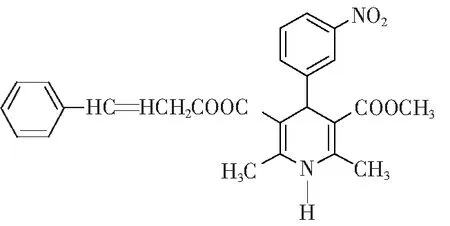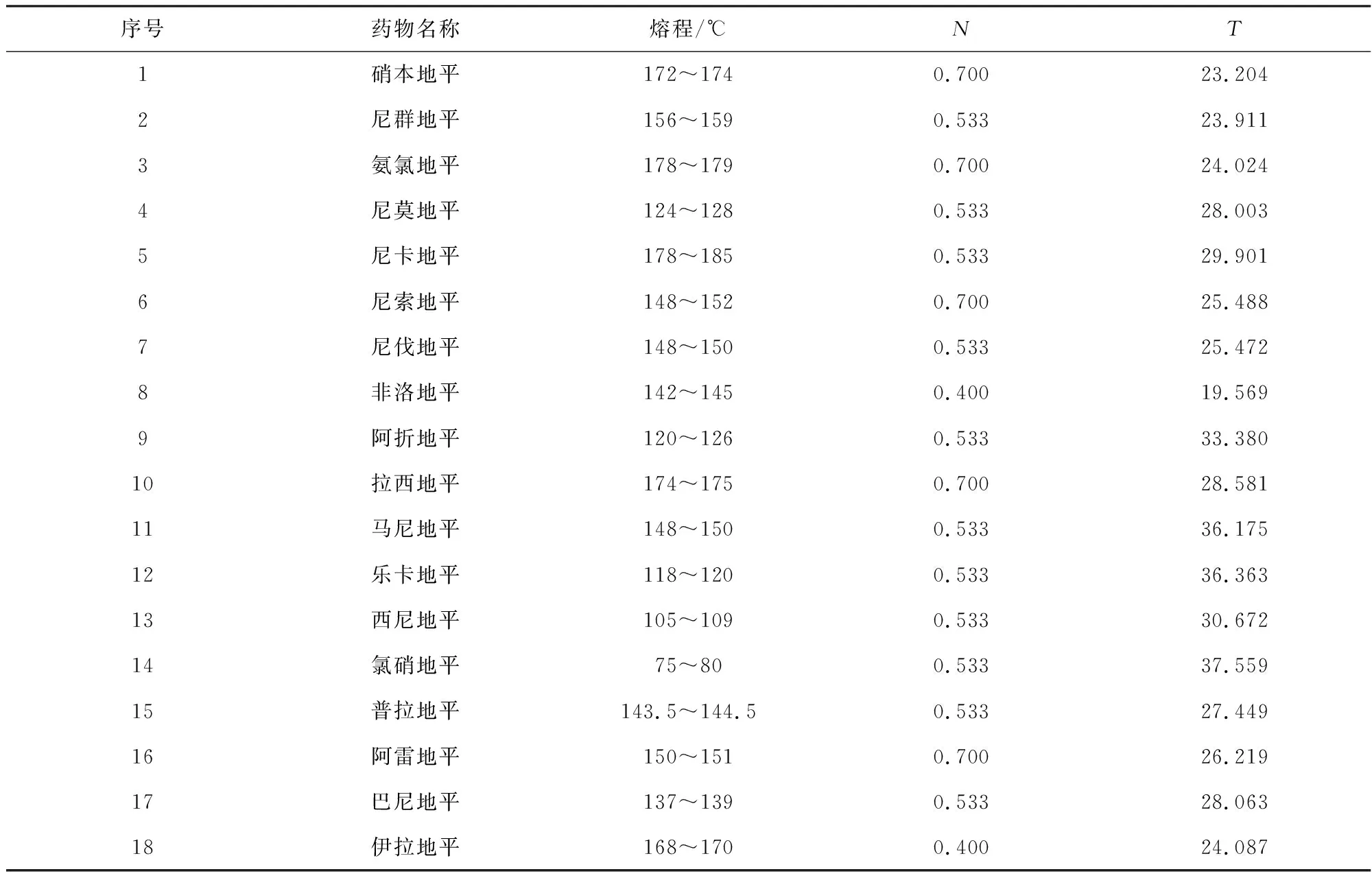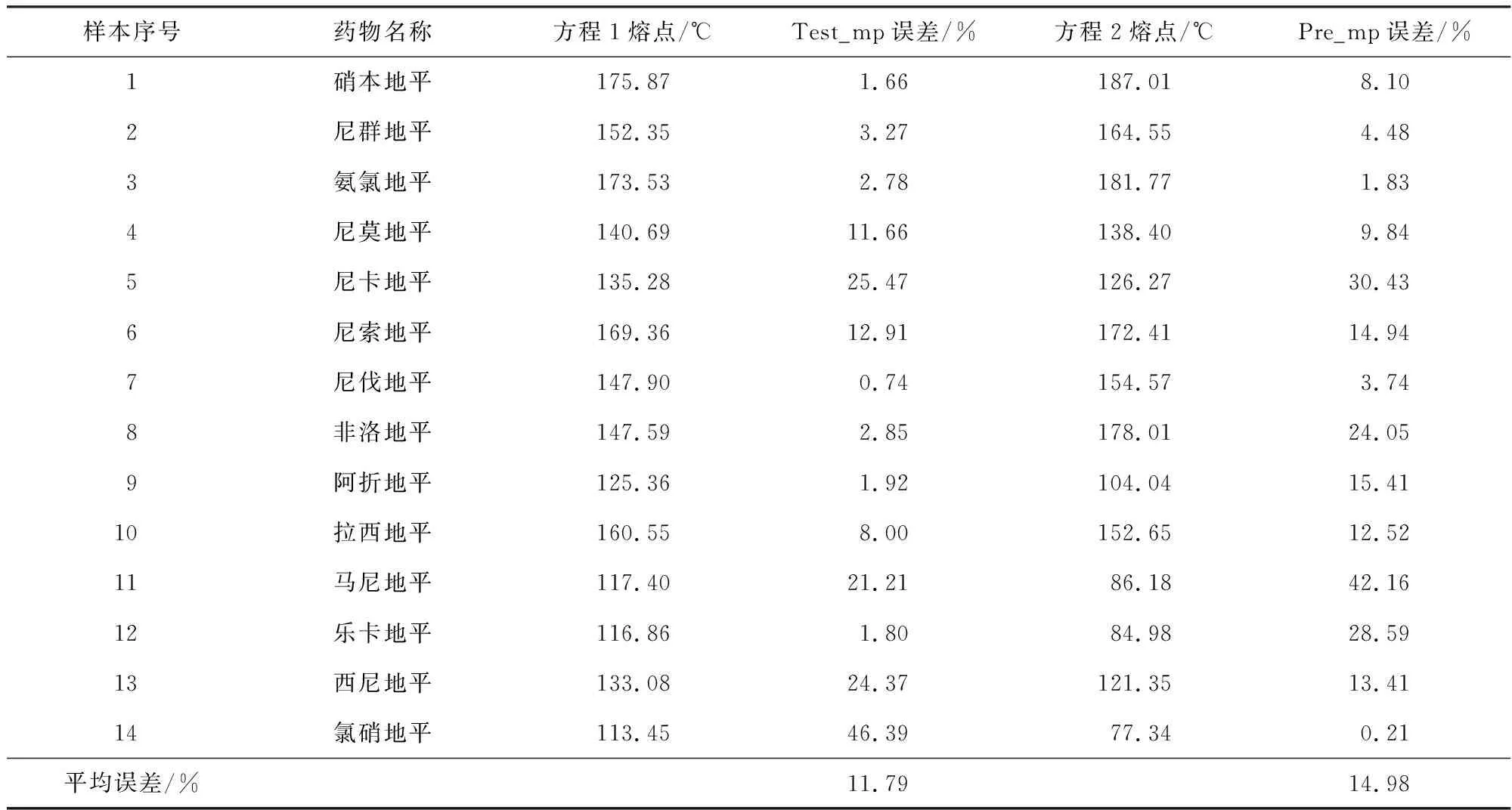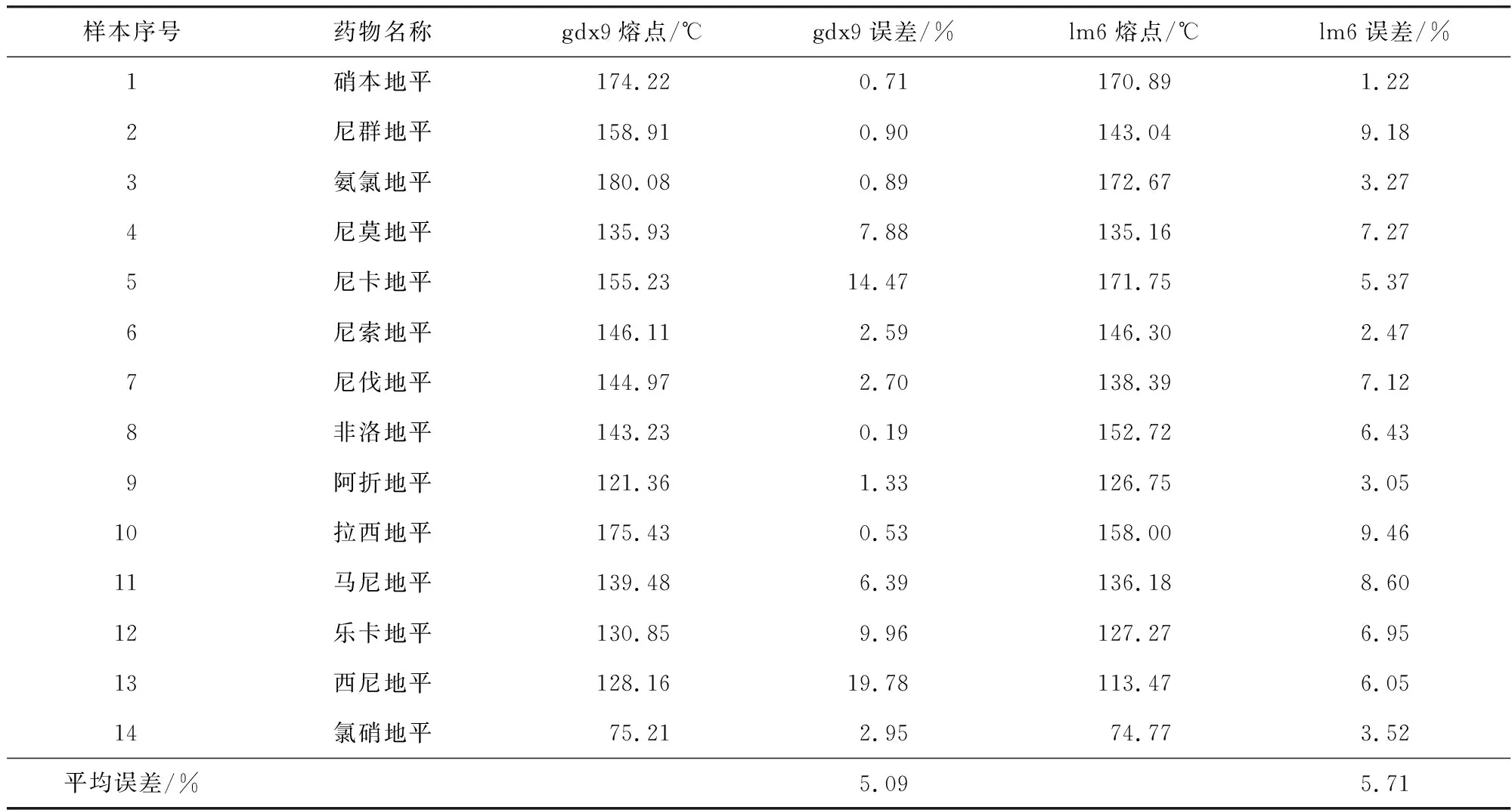用MATLAB程序预测地平类药物的熔点
李志伟,郭海谦,吴 芬
(1.河北科技大学化学与制药工程学院,河北石家庄 050018;2.石药集团欧意药业有限公司,河北石家庄 050051)
药物的性质很大程度上取决于药物分子的结构,通过分析药物分子的结构,可以发现药物的性质和结构之间存在的某种定量关系[1]。许多因素都影响药物的各种理化性质,如在化合物分子中分子的电荷分布及立体因素、官能团的位置等。许多学者也用人工神经网络或回归方程等方法对各种药物进行研究[2-14]。
1 参数及模型
根据文献[4]中的方法对地平类药物构建相似的分子参数N和T,与该药物的熔点进行关联,构建预测的数学模型,得到地平类药物的熔点计算值。普拉地平分子结构见图1。

图1 普拉地平分子结构Fig.1 Molecular structure of pranidipine
例如:对普拉地平的分子参数N,T进行计算:
T=(δ0)-0.5× 6+(δNH)-0.5+(δN)-0.5+(δC)-0.5×9+(δCH)-0.5×12+(δCH2)-0.5+(δCH3)-0.5×3=1.808×6+0.280 +1.191+0.5×9+0.577×12+0.707+1×3=27.449,
N=0.2+1/3=0.533。
依照上述计算方法,将地平类药物的熔点、分子参数N和T值列入表1。

表1 地平类药物熔点实验值与分子参数N,T
2 编制程序
2.1 回归方程程序
mmin=[172 156 178 124 178 148 148 142 120 174 148 118 105 75];
mmax=[174 159 179 128 185 152 150 145 126 175 150 120 109 80];
format bank;
mpm=(mmin+mmax)/2%程序所用熔点均为熔程平均值
n=[0.7 0.533 0.7 0.533 0.533 0.7 0.533 0.4 0.533 0.7 0.533 0.533 0.533 0.533]′;
t=[23.204 23.911 24.024 28.003 29.901 25.488 25.472 19.569 33.380 28.581 36.175 36.363 30.672 37.559]′;
y=[mpm]′;
x=[ones(14,1) n t]; %对数据拟合新的方程,同时和文献中方程作图对比;
[b,bint,r,rint,stats]=regress(y,x);
figure;
rcoplot(r,rint);
pre_mp=~6.393 1*t+107.425 78*n+260.080 9;
mp=b(3)*t+b(2)*n+b(1);
no=1:14;
figure;
plot(no,mmin,'ro',no,pre_mp,'*',no,mmax,'ro');
figure;
plot(no,mmin,'ro',no,mp,'*',no,mmax,'ro');
[t1,n1]=meshgrid(18:2:38,0.8:~0.1:0.3);
mp3=~6.393 1*t1+107.425 78*n1+260.080 9;
mp4=b(3)*t1+b(2)*n1+b(1);
figure;
set(gcf,'defaultlinelinewidth',1.5);
plot3(t,n,pre_mp,'~y*'),hold on,surf(t1,n1,mp3),shading interp,hold on,…
plot3(t,n,mp,'~~m'),hold on,surf(t1,n1,mp4),shading interp,…
hold on,plot3(t,n,mmin,'o'),hold on,plot3(t,n,mmax,'v'),xlabel('T'),ylabel('N'),…
zlabel('melting point'),title('Surfaces Before and after the Curve Fitting');
choose=input('Do you want to test 4 groups of data,input "1" to go on or"0" to stop.');
if (choose==0),break;
else
n15=input('test 15th N: ');
t15=input('test 15th T: ');
Test_mp15=b(3)*t15+b(2)*n15+b(1)
Pre_mp15=~6.393 1*t15+107.425 78*n15+260.080 9
余下3个药物验证程序略去。
2.2 神经网络程序
数据输入部分略。
P(2,:)=(p(2,:)~min(p(2,:)))/(max(p(2,:))~min(p(2,:))); % p为参数T,N组成的矩阵
T=(t~min(t))/(max(t)~min(t)); % t为熔程平均值
rand('state',0);
%net=newff(minmax(P),[6,1],{'tansig','purelin'},'trainlm');
net=newff(minmax(P),[9,1],{'tansig','purelin'},'traingdx');
%以上两行可交替注释屏蔽训练
net=init(net)
net.trainParam.epochs = 10 000;
net.trainParam.goal = 0.01;
[net,tr]=train(net,P,T);
mmin=[172 156 178 124 178 148 148 142 120 174 148 118 105 75];
mmax=[174 159 179 128 185 152 150 145 126 175 150 120 109 80];
format bank;
mp=sim(net,P).*(max(t)~min(t))+min(t)
no=1:14;
figure;
plot(no,mmin,'ro',no,mp,'*',no,mmax,'ro');
choose=input('Do you want to test 4 groups of data,input "1" to go on or"0" to stop.');
if (choose==0),break;
else
N15=input('test 15th N: ');
t15=input('test 15th T: ');
T15=(t15~min(p(2,:)))/(max(p(2,:))~min(p(2,:)));
Test_mp=sim(net,[N15 T15]').*(max(t)~min(t))+min(t)
余下3个药物验证程序略去。
3 运行结果
3.1 回归方程程序运行结果
程序拟合所得方程为
Test_mp= ~ 2.85T+128.79N+151.85。
(1)
文献[4]中方程为
Pre_mp= ~6.39T+107.43N+260.08。
(2)
回归方程法熔点计算值及误差见表2。

表2 回归方程法熔点计算值及误差Tab.2 Calculation values of RE method and errors
其余4组验证数据见表3。

表3 回归方程法熔点预测值及误差验证
3.2 神经网络程序运行结果
神经网络法熔点计算值及误差见表4。

表4 神经网络法熔点计算值及误差
其余4组验证数据见表5。

表5 神经网络法熔点预测值及误差验证
4 结果与讨论
以上数据的结果表明,重新拟合的回归方程比文献[4]中方程更适合于计算地平类药物的熔点。但回归方程法预测结果与实验值比较平均误差在10%左右,而神经网络方法平均误差在5%左右,人工神经网络预测值的结果比回归方程更接近实验值。以上2个方法若进一步完善也可以对其他药物熔点进行更精准的预测,为进一步研究药物的其他理化性质及药物活性提供帮助。而其中的BP神经网络具有设计简单的优点[15],具有较好的预测和泛化能力,为复杂、高度非线性问题的解决提供了途径。因此,BP神经网络可作为药物构效关系及计算机辅助药物设计的有效方法。
用MATLAB处理数据比较方便,而且能进行非线性拟合。作为高级计算机语言,MATLAB具有强大的计算能力,它将成为药物科研人员进行数据处理及试验设计的得力助手。
参考文献/References:
[1] 宋 倩,梅向东,宁 君. 生物电子等排原理在农药与医药开发中的应用[J]. 河北工业科技,2009,26(2):131-136.
SONG Qian, MEI Xiangdong, NING Jun. Application of bioisosterism in pesticide and medicine development[J]. Hebei Journal of Industrial Science and Technology, 2009,26(2):131-136.
[2] HECHT D, CHEUNG M, FOGEL G B. QSAR using evolved neuralnetworks for the inhibition of mutant PfDHFR by pyrimethamine derivatives[J]. Biosystems, 2008, 92(1): 10-15.
[3] FOMENKO I, DURST M, BALABAN D. Robust regression for high throughput drug screening[J]. Computer Methods and Programs in Biomedicine, 2006, 82:31-37.
[4] 周燕平, 焦 健, 周先锋, 等. 碳酸酐酶XIV抑制剂的定量构效关系研究[J].华中师范大学学报(自然科学版), 2010, 44(4): 618-622.
ZHOU Yanping, JIAO Jian, ZHOU Xianfen, et al. QSAR studies of sulfonamides as the carbonic anhydrase XIV inhibitors by artificial neural network-based transformation for nonlinear partial least-square regression[J]. Journal of Huazhong Normal University (Natural Sciences),2010,44(4):618-622.
[5] LEOW J L, BARON R, CASEY P J, et al. Quantitative structure-activity relationship (QSAR) of indoloacetamides as inhibitors of human isoprenylcysteine carboxyl methyltransferase[J]. Bioorganic and Medicinal Chemistry Letters, 2007, 17(4): 1 025-1 032.
[6] HEMMATEENEJAD B, SHAMSIPUR M. Quantitative structure electrochemistry relationship study of some organic compounds using PC-ANN and PCR[J]. Internet Electronic Journal of Molecular Design, 2004, 3(6): 316-334.
[7] 周 鲁,夏昆华. 喹诺酮类化合物的定量构动关系[J].华西药学杂志, 2006, 21(5): 433-435.
ZHOU Lu, XIA Kunhua. The quantative structure-pharmacokinetic relationship of quinolones compounds[J]. West China Journal of Pharmaceutical,2006, 21(5): 433-435.
[8] 陈国华,陆 瑶,陈 虹. 基于逐步回归所得变量集的遗传反向传播神经网络的QSAR研究[J]. 计其机与应用化学,2010,27(9):1 257-1 262.
CHEN Guohua, LU Yao, CHEN Hong. The QSAR study of backpropagation neural network using genetic algrithm based on variable pool selected by stepwise linear regression[J]. Computers and Applied Chemistry,2010,27(9):1 257-1 262.
[9] 堵锡华,陈 艳,唐自强,等.抗糖尿病新药熔点的定量构效关系研究[J]. 南京工业大学学报,2006,28(2):98-100.
DU Xihua, CHEN Yan, TANG Ziqiang, et al. QSPR research for melting point of new antidiabetic drugs[J]. Journal of Nanjing University of Technology,2006,28(2):98-100.
[10] 高鸿斌,张永强,张 佳. BP-神经网络算法在分布式VOD系统流量预测中的应用[J]. 河北科技大学学报, 2001, 22(3): 23-26.
GAO Hongbin, ZHANG Yongqiang, ZHANG Jia. Applicationof BP-neural networktonetwork-flow predictionof distributed VOD system[J]. Journal of Hebei University of Science and Technology, 2001, 22(3): 23-26.
[11] HANGAN M T, DEMUTH H B, BEALE M. Neural Network Design[M].Beijing: China Machine Press,2002.
[12] KAHANER D, MOLER C B, NASH S. Numerical Methods and Software[M]. Englewood Cliffs: Prentice Hall, 1989.
[13] SMITH B T, BOYLE J M, DONGARRA J J, et al. Matrix Eigensystem Routines-EISPACK Guide[M]. 2nd ed. New York: Springer-Verlag, 1976.
[14] 郝平娇, 李士雨. 浅谈MATLAB在化工计算中的应用[J]. 计算机与应用化学, 2000,17(4): 371-374.
HAO Pingjiao, LI Shiyu. Applications of MATLAB in chemical engineering calculating[J]. Computers and Applied Chemistry, 2000,17(4): 371-374.
[15] 冯 剑. MATLAB在化工计算中的应用[J]. 化学工程师, 2008, 22(5): 25-27.
FENG Jian. Applications of MATLAB in chemical engineering calculating[J]. Chemical Engineer, 2008, 22(5): 25-27.

